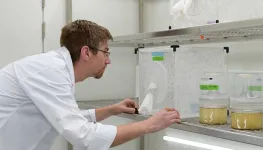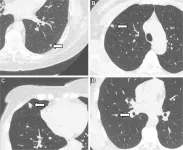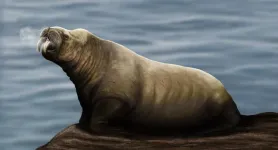(Press-News.org) A Macquarie University team proposes using genetically engineered black soldier flies (Hermetia illucens) to address worldwide pollution challenges and produce valuable raw materials for industry, including the USD $500 billion global animal feed market.
In a new paper published on 24 July in the journal Communications Biology, scientists at Macquarie University outline a future where engineered flies could transform waste management and sustainable biomanufacturing, addressing multiple United Nations Sustainable Development Goals (SDGs).
Synthetic biologist Dr Kate Tepper is lead author of the paper and a Postdoctoral Research Fellow at Applied BioSciences, Macquarie University.
“One of the great challenges in developing circular economies is making high-value products that can be produced from waste,” says Dr Tepper.
Landfill Emitters
An estimated 40 to 70 per cent of global organic waste finds its way to landfills.
“The landfilling of organic waste creates about five per cent of annual global greenhouse gas emissions and we need to get this to zero per cent,” Dr Tepper says.
Organic by-products from sewage treatment - municipal biosolids - can be used as an alternative to synthetic fertiliser to grow crops and close nutrient cycles.
However Dr Tepper notes there are rising concerns about toxic chemicals in waste, including dangerous ‘forever chemicals’ such as per- and poly-fluoroalkyl substances (PFAS).
In developing countries, organic wastes dumped in open areas can contaminate water used for drinking or irrigation, attracting pests, spreading disease and degrading natural habitat, and farmers often burn leftover crop parts they can’t use, causing air pollution.
Black soldier flies are already valued in waste management where they consume commercial organic wastes before being processed as ‘insect biomass’ into foods for domestic pets and commercial chicken and fish farmers.
But the Macquarie team believes genetic engineering could extend the usefulness of the black soldier fly, enabling them to turn waste inputs into enhanced animal feeds or valuable industrial raw materials.
The larvae could bio-manufacture industrial enzymes currently for use in livestock, textile, food and pharmaceutical industries and representing a global market worth billions of dollars annually.
The flies can also be engineered to generate specialised lipids for use in biofuels and lubricants, replacing fossil-fuel derived products.
Engineering insects to make industrial enzymes and lipids that are not used in food supply chains will expand the types of organic wastes that can be used, and the research team propose modifying the fly so it can digest contaminated organic wastes, sewage sludge, and other complex organic wastes.
“Even the fly-poo, called ‘frass,’ could be enhanced to improve fertiliser,” Dr. Tepper says. “The flies could be engineered to clean up chemical contaminants in their frass, which can be applied as pollutant free fertiliser to grow crops and prevent contaminants entering our food supply chains.”
Sustainable biomanufacturing
Senior author Dr Maciej Maselko, who heads an animal synthetic biology lab at Macquarie University’s Applied BioSciences, says: “Insects will be the next frontier for synthetic biology applications, dealing with some of the huge waste-management challenges we haven’t been able to solve with microbes.”
Genetically engineered microbes require sterile environments to prevent contamination, along with lots of water and refined nutrient inputs.
“We can feed black soldier flies straight, dirty trash rather than sterilised or thoroughly pre-processed. When it is just chopped into smaller pieces black soldier flies will consume large volumes of waste a lot faster than microbes,” Dr Maselko says.
The researchers suggest genetic engineering could piggyback on the existing framework, elevating the flies from simple waste processors to high-tech biomanufacturing platforms. In the paper the researchers outline a roadmap calling for better genetic engineering tools in key insects.
“Physical containment is part of a series of protections. We are also developing additional layers of genetic containment so that any escapees can’t reproduce or survive in the wild,” Dr Maselko says.
Commercialisation
Macquarie University in partnership with some members of the research team has filed patent applications related to black soldier fly biomanufacturing, already underway through a Macquarie University spin-out company, EntoZyme.
Dr Tepper says that the introduction of genetically engineered insects has potential, not just in the multi-billion dollar waste management market, but also in the production of a range of high-value industrial inputs.
“If we want a sustainable circular economy, the economics of that have to work,” says Dr Tepper.
“When there is an economic incentive to implement sustainable technologies, such as engineering insects to get more value from waste products, that will help to drive this transition more rapidly.”
END
Reduce, reuse, reflycle
How genetically modified flies can reduce waste and keep it out of landfills
2024-08-13
ELSE PRESS RELEASES FROM THIS DATE:
Lung nodules seen in a high percentage of non-smokers
2024-08-13
OAK BROOK, Ill. – A new study of more than 10,000 non-smoking adults found that solid lung nodules were present in a considerable portion of study participants. Non-smokers are traditionally thought to be at low risk for lung nodules and lung cancer. The results of the study were published today in Radiology, a journal of the Radiological Society of North America (RSNA).
Incidental lung nodules are common findings on chest CT and in high-risk groups are more likely to be a sign of early-stage lung cancer. Because most previous research on the prevalence and size of lung nodules has typically been ...
Study shows text messages help youth at risk for suicide feel supported after discharge
2024-08-13
(COLUMBUS, Ohio) – As the nation’s youth mental health crisis continues, providers continue to find ways to help address gaps in care. Patients who receive care for suicidal thoughts and behaviors need extra support as they transition after they are discharged from inpatient care or the emergency department.
Caring Contacts are validating messages sent to patients via text messages, postcards or letters to offer patients ongoing care and support without placing any demands (such as reminders to attend their next appointment). At Nationwide ...
About 10,000 chemistry presentations will happen in Denver soon
2024-08-13
WASHINGTON, Aug. 13, 2024 — The American Chemical Society (ACS) is hosting ACS Fall 2024, its virtual and in-person meeting, with the theme “Elevating Chemistry.” It will take place in Denver on Aug. 18-22.
About 10,000 presentations will feature cutting-edge developments on a range of scientific topics at ACS Fall 2024. Embargoed press releases and videos are available to members of the media on the EurekAlert! website. Reporters can also email newsroom@acs.org to request access to the embargoed content. View the ACS Fall 2024 schedule for a full list of in-person, hybrid ...
Protecting surf breaks mitigates climate change, helps coastal communities, analysis finds
2024-08-13
CORVALLIS, Ore. – Safeguarding places to hang ten and shoot the curl is an opportunity to simultaneously mitigate climate change, fuel tourism and help surrounding ecosystems, new research has shown.
“There is a growing conservation movement regarding coastal areas that host surf breaks,” said Jacob Bukoski of Oregon State University, one of the study’s co-authors. “Earlier research showed that surf breaks tend to be biodiversity hotspots, but no one had looked at the stocks of carbon held within these ecosystems – carbon that could drive climate change if ...
New species of extinct walrus-like mammal discovered in the North Atlantic
2024-08-13
A new discovery by a team of paleontologists, led by Dr. Mathieu Boisville (University of Tsukuba, Japan), has uncovered a new species of the extinct genus Ontocetus from the Lower Pleistocene deposits in the North Atlantic. This species, named Ontocetus posti, displays surprising similarities in feeding adaptations to the modern walrus (Odobenus rosmarus), highlighting an intriguing case of convergent evolution. The research is published in the open access journal PeerJ Life & Environment.
The fossils ...
Empowering women – a key to both sustainable energy and gender justice
2024-08-13
Involving women in implementing solar energy technologies in developing countries not only has great climate impact. A new study published in Nature Energy and carried out by researchers from Chalmers University of Technology, Sweden, shows that empowering women through energy care work can change unjust, gendered norms and long-lived injustices.
Unlike going from fossil to renewable fuels within the transport sector, transitioning to renewable energy for electricity production is often done at the local level due to decentralised energy providers. Around the world, there are community-led programmes that provide solar, wind and hydro power, as alternative, greener energy sources. ...
Delivery robots’ green credentials make them more attractive to consumers
2024-08-13
PULLMAN, Wash. – The smaller carbon footprint, or wheel print, of automatic delivery robots can encourage consumers to use them when ordering food, according to a Washington State University study.
The suitcase-sized, self-driving electric vehicles are much greener than many traditional food delivery methods because they have low, or even zero, carbon emissions. In this study, participants who had more environmental awareness and knowledge about carbon emissions were more likely to choose the robots as ...
Mayo Clinic offers new innovative therapy to treat atrial fibrillation
2024-08-13
ROCHESTER, Minn. — Cardiologists in Mayo Clinic's Heart Rhythm Clinic are using a new innovative energy source to safely and successfully treat a common type of heart arrhythmia. The therapy, called pulsed field ablation (PFA), has received Food and Drug Administration (FDA) approval and represents a significant milestone in treating atrial fibrillation (AFib).
The irregular and often very rapid heart rhythm of AFib can lead to blood clots in the heart, increasing a patient's risk of stroke. Clinicians can use medication and therapies to help reset the heart rhythm, but some patients have AFib that ...
Changing food consumers' choices may help cut greenhouse gases
2024-08-13
Planet-warming greenhouse gas emissions associated with the global food supply chains induced by diets could fall by 17% if people change their food choices towards more plant-based diets, a new study reveals.
Researchers believe that a currently over-consuming 56.9% of the global population would save 32.4% of global dietary emissions by changing their diet to the planetary health diet proposed by the EAT-Lancet Commission.
Publishing their findings today (13 Aug) in Nature Climate Change, an international group of researchers note that a diet switch to the planetary health diet would balance the ...
Significant link found between heme iron, found in red meat and other animal products, and type 2 diabetes risk
2024-08-13
Key points:
Researchers identified a significant link between heme iron—iron found in red meat and other animal products —and risk of type 2 diabetes (T2D), as well as the metabolic pathways underlying the link.
Non-heme iron—iron found in plant-based foods—was not associated with risk of T2D.
The study suggests that cutting down on heme iron from red meat and adopting a plant-rich diet can help lower diabetes risk. And it raises concerns about the addition of heme to increasingly popular plant-based meat alternatives.
Boston, MA—Higher intake ...
LAST 30 PRESS RELEASES:
Why nail-biting, procrastination and other self-sabotaging behaviors are rooted in survival instincts
Regional variations in mechanical properties of porcine leptomeninges
Artificial empathy in therapy and healthcare: advancements in interpersonal interaction technologies
Why some brains switch gears more efficiently than others
UVA’s Jundong Li wins ICDM’S 2025 Tao Li Award for data mining, machine learning
UVA’s low-power, high-performance computer power player Mircea Stan earns National Academy of Inventors fellowship
Not playing by the rules: USU researcher explores filamentous algae dynamics in rivers
Do our body clocks influence our risk of dementia?
Anthropologists offer new evidence of bipedalism in long-debated fossil discovery
Safer receipt paper from wood
Dosage-sensitive genes suggest no whole-genome duplications in ancestral angiosperm
First ancient human herpesvirus genomes document their deep history with humans
Why Some Bacteria Survive Antibiotics and How to Stop Them - New study reveals that bacteria can survive antibiotic treatment through two fundamentally different “shutdown modes”
UCLA study links scar healing to dangerous placenta condition
CHANGE-seq-BE finds off-target changes in the genome from base editors
The Journal of Nuclear Medicine Ahead-of-Print Tip Sheet: January 2, 2026
Delayed or absent first dose of measles, mumps, and rubella vaccination
Trends in US preterm birth rates by household income and race and ethnicity
Study identifies potential biomarker linked to progression and brain inflammation in multiple sclerosis
Many mothers in Norway do not show up for postnatal check-ups
Researchers want to find out why quick clay is so unstable
Superradiant spins show teamwork at the quantum scale
Cleveland Clinic Research links tumor bacteria to immunotherapy resistance in head and neck cancer
First Editorial of 2026: Resisting AI slop
Joint ground- and space-based observations reveal Saturn-mass rogue planet
Inheritable genetic variant offers protection against blood cancer risk and progression
Pigs settled Pacific islands alongside early human voyagers
A Coral reef’s daily pulse reshapes microbes in surrounding waters
EAST Tokamak experiments exceed plasma density limit, offering new approach to fusion ignition
Groundbreaking discovery reveals Africa’s oldest cremation pyre and complex ritual practices
[Press-News.org] Reduce, reuse, reflycleHow genetically modified flies can reduce waste and keep it out of landfills





